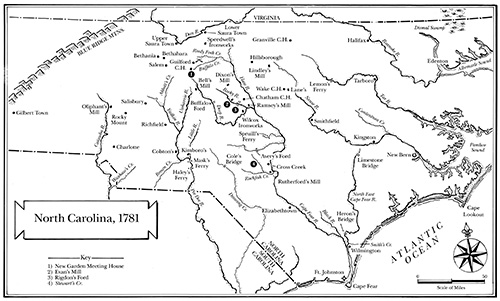Major General Lafayette to George Washington, 8 May 1781
From Major General Lafayette
Richmond May the 8th 1781
My Dear General
There is no fighting Here Unless you Have a Naval Superiority or an Army Mounted upon Race Horses—phillip’s plan Against Richmond Has Been Defeated, He Was Going towards portmouth,1 and I thought it should Be enough for Me to Oppose Him At Some principal points in this State—But Now it Appears I Will Have Business to transact With two Armies and this is Rather too Much.
By letters from North Carolina I find that Lord Cornwallis who I Had Been Assured Had Sailed for Charlestown is Advancing towards Hallifax2—in Consequence of letters from the Same Quarter General phillips Has Altered His plans and Returned to a place Called Brandon on the South Side of james River Where He Landed the Night Before Last3—our detachement is Under March towards the Hallifax Road—His Command of the Water Enabled Him to Land Where I Could not Reach Him—the Bridge at peters Burg is destroïed, and Unles He Acts With an Uncommon degree of Folly He Will Be at Halifax Before me4—Each of these Armies is More than the double Superior to me—We Have no Boats, few Militia, and less Arms—I will try to do for the Best, and Hope to deserve Your Approbation.
Nothing Can attract My sight from the Supplies and Reinforcements destined to General Greene’s Army—While I am Going to Get Beaten By Both Armies or Each of them Separately the Baron Remains at Richmond Where He Hurries the Collection of Recruits and Every other Requisite5—I Have forbidded Every departement to Give me Any thing that May Be thought Useful to General Greene, and should a Battle Be Expected (an Event which I will try to keep off) No Consideration Will prevent our Sending to Carolina 800 Recruits who, I Hope, May Be Equipped in a fortnight—When General Greene Becomes Equal to offensive operations this6 Quarter Will Be Relieved—I Have wrote to Waïne to Hasten His March7 But Unless I am Very Hard pushed Shall Request Him to proceed southward—the Militia Has Been ordered out But are slow, Unarmed, and not yet used to this Business—General Greene from whom I Had as yet no letters Was on the 26 Before Camden But did not think Himself Equal to the Storming of the Works.8 Most Respectfully and Affectionately, My Dear General Yours
Lafayette
My Respects, if you please, to Mistress Washington and Compliments to the family.9
ALS, DLC:GW; copy (incomplete), PEL. The copy contains only the last eighty words of the letter (see n.6 below). GW acknowledged this letter when he wrote Lafayette on 31 May (second letter).
1. For Maj. Gen. William Phillips’s raid up the James River toward Richmond, see Lafayette to GW, 4 May, n.2; see also Thomas Jefferson to GW, 9 May.
2. These letters have not been identified. Lt. Gen. Charles Cornwallis was marching his army north from Wilmington, North Carolina. Advanced elements of his army had arrived in Halifax, N.C., on 7 May (see Benedict Arnold to Henry Clinton, 12 May, in , 20:142–45).
3. Cornwallis had written Phillips from Wilmington on 24 April that he intended to “immediately march up the country … to try to form a junction.” Cornwallis instructed Phillips to “make every movement in your power to facilitate our meeting (which must be somewhere near Petersburg)” (, 4:116). Phillips then ordered his army toward Petersburg. They arrived at Brandon near 5:00 P.M. on 7 May and remained there on 8 May (see Arnold to Clinton, 12 May, in , 20:142–45).
Brandon, the plantation house of GW’s friend Nathaniel Harrison, was located on the south side of the James River in Prince George County about halfway between Richmond and Portsmouth (see the entry for 4 Sept. 1768 in , 2:92; see also GW to Bartholomew Dandridge, c.12 Feb. 1774, in 9:471–74).
4. Lafayette refers to the Pocahontas Bridge across the Appomattox River, which had carried the road from Petersburg to Halifax prior to its destruction to cover a Continental retreat (see Steuben to GW, 25 April). Lafayette mistakenly assumed that the British would march to Halifax (see Lafayette to GW, 18 May, and n.2 to that document).
5. Major General Steuben reported to Maj. Gen. Nathanael Greene on 15 May that 430 recruits had gathered at Albemarle barracks but were “Unarmed, Unequip’d & without Cloaths.” He did not “expect above 400 more” (, 8:267–68).
6. The copy begins with this word.
7. Lafayette wrote Brig. Gen. Anthony Wayne on 7 May (see , 4:492; see also Wayne to GW, same date).
8. Greene had engaged the British army outside Camden, S.C., at the Battle of

Map 2. Having pursued Maj. Gen. Nathanael Greene across much of North Carolina, Cornwallis raced north from Wilmington to Virginia, where Lafayette awaited. (Illustrated by Rick Britton. Copyright Rick Britton 2022)
9. On the copy, material in the postscript appears before the close.

![University of Virginia Press [link will open in a new window] University of Virginia Press](/lib/media/rotunda-white-on-blue.png)
